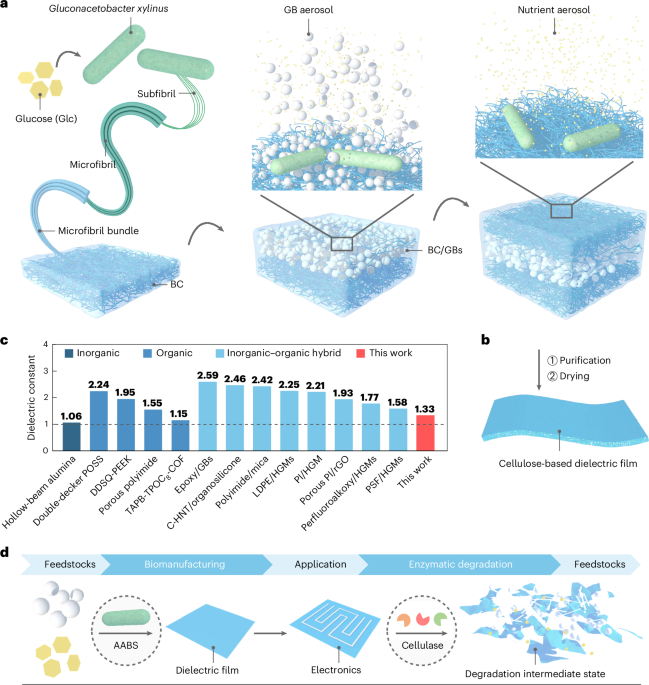Wang, Z., Zhang, B. & Guan, D. Take responsibility for electronic-waste disposal. Nature 536, 23–25 (2016).
Awasthi, A. K., Li, J., Koh, L. & Ogunseitan, O. A. Circular economy and electronic waste. Nat. Electron. 2, 86–89 (2019).
Weidenkaff, A., Wagner-Wenz, R. & Veziridis, A. A world without electronic waste. Nat. Rev. Mater. 6, 462–463 (2021).
Zabala, A. Illegal electronic waste recycling trends. Nat. Sustain. 2, 353–354 (2019).
Science to Enable Sustainable Plastics—A White Paper from the 8th Chemical Sciences and Society Summit (CS3) (Royal Society of Chemistry, 2020).
Chen, Y. et al. Selective recovery of precious metals through photocatalysis. Nat. Sustain. 4, 618–626 (2021).
Li, W. et al. Biodegradable materials and green processing for green electronics. Adv. Mater. 32, e2001591 (2020).
Hwang, S.-W. et al. A physically transient form of silicon electronics. Science 337, 1640–1644 (2012).
Han, W. B., Lee, J. H., Shin, J. W. & Hwang, S. W. Advanced materials and systems for biodegradable, transient electronics. Adv. Mater. 32, e2002211 (2020).
Teng, L. et al. Liquid metal-based transient circuits for flexible and recyclable electronics. Adv. Funct. Mater. 29, 1808739 (2019).
Williams, N. X., Bullard, G., Brooke, N., Therien, M. J. & Franklin, A. D. Printable and recyclable carbon electronics using crystalline nanocellulose dielectrics. Nat. Electron. 4, 261–268 (2021).
Shi, C. et al. Heterogeneous integration of rigid, soft, and liquid materials for self-healable, recyclable, and reconfigurable wearable electronics. Sci. Adv. 6, eabd0202 (2020).
Zhang, S. et al. Biomimetic spinning of soft functional fibres via spontaneous phase separation. Nat. Electron. 6, 338–348 (2023).
Irimia-Vladu, M. “Green” electronics: biodegradable and biocompatible materials and devices for sustainable future. Chem. Soc. Rev. 43, 588–610 (2014).
Kwon, J. et al. Conductive ink with circular life cycle for printed electronics. Adv. Mater. 34, e2202177 (2022).
Christensen, P. R., Scheuermann, A. M., Loeffler, K. E. & Helms, B. A. Closed-loop recycling of plastics enabled by dynamic covalent diketoenamine bonds. Nat. Chem. 11, 442–448 (2019).
Haussler, M., Eck, M., Rothauer, D. & Mecking, S. Closed-loop recycling of polyethylene-like materials. Nature 590, 423–427 (2021).
Zhang, Z. et al. Strong and tough supramolecular covalent adaptable networks with room-temperature closed-loop recyclability. Adv. Mater. 35, 2208619 (2023).
Liu, Y. et al. Closed-loop chemical recycling of thermosetting polymers and their applications: a review. Green Chem. 24, 5691–5708 (2022).
Sullivan, K. P. et al. Mixed plastics waste valorization through tandem chemical oxidation and biological funneling. Science 378, 207–211 (2022).
DelRe, C. et al. Near-complete depolymerization of polyesters with nano-dispersed enzymes. Nature 592, 558–563 (2021).
Hatti-Kaul, R., Nilsson, L. J., Zhang, B., Rehnberg, N. & Lundmark, S. Designing biobased recyclable polymers for plastics. Trends Biotechnol. 38, 50–67 (2020).
Hadley Kershaw, E., Hartley, S., McLeod, C. & Polson, P. The sustainable path to a circular bioeconomy. Trends Biotechnol. 39, 542–545 (2021).
Kakadellis, S. & Rosetto, G. Achieving a circular bioeconomy for plastics. Science 373, 49–50 (2021).
Vollmer, I. et al. Beyond mechanical recycling: giving new life to plastic waste. Angew. Chem. Int. Ed. 59, 15402–15423 (2020).
Coates, G. W. & Getzler, Y. D. Chemical recycling to monomer for an ideal, circular polymer economy. Nat. Rev. Mater. 5, 501–516 (2020).
Wang, C., Yokota, T. & Someya, T. Natural biopolymer-based biocompatible conductors for stretchable bioelectronics. Chem. Rev. 121, 2109–2146 (2021).
Li, T. et al. Developing fibrillated cellulose as a sustainable technological material. Nature 590, 47–56 (2021).
Iguchi, M., Yamanaka, S. & Budhiono, A. Bacterial cellulose—a masterpiece of nature’s arts. J. Mater. Sci. 35, 261–270 (2000).
Guan, Q. F., Han, Z. M., Ling, Z. C., Yang, H. B. & Yu, S. H. Growing bacterial cellulose-based sustainable functional bulk nanocomposites by biosynthesis: recent advances and perspectives. Acc. Mater. Res. 3, 608–619 (2022).
Guan, Q. F. et al. A general aerosol-assisted biosynthesis of functional bulk nanocomposites. Natl Sci. Rev. 6, 64–73 (2019).
Guan, Q. F., Ling, Z. C., Han, Z. M., Yang, H. B. & Yu, S. H. Ultra-strong, ultra-tough, transparent, and sustainable nanocomposite films for plastic substitute. Matter 3, 1308–1317 (2020).
Guan, Q. F., Han, Z. M., Ling, Z. C., Yang, H. B. & Yu, S. H. Sustainable wood-based hierarchical solar steam generator: a biomimetic design with reduced vaporization enthalpy of water. Nano Lett. 20, 5699–5704 (2020).
Yin, C. H. et al. Multiscale cellulose-based fireproof and thermal insulation gel materials with water-regulated forms. Nano Res. 16, 3379–3386 (2023).
Mattos, B. D. et al. Nanofibrillar networks enable universal assembly of superstructured particle constructs. Sci. Adv. 6, eaaz7328 (2020).
Zhang, Y., Liu, Z., Zhang, X. & Guo, S. Sandwich-layered dielectric film with intrinsically excellent adhesion, low dielectric constant, and ultralow dielectric loss for a high-frequency flexible printed circuit. Ind. Eng. Chem. Res. 60, 11749–11759 (2021).
Tournier, V. et al. An engineered PET depolymerase to break down and recycle plastic bottles. Nature 580, 216–219 (2020).
Nogueira, G., Capaz, R., Franco, T., Dias, M. & Cavaliero, C. Enzymes as an environmental bottleneck in cellulosic ethanol production: does on-site production solve it? J. Clean. Prod. 369, 133314 (2022).
Shi, X. et al. Scalable production of carboxylated cellulose nanofibres using a green and recyclable solvent. Nat. Sustain. 7, 315–325 (2024).
Lu, Y., Mehling, M., Huan, S., Bai, L. & Rojas, O. J. Biofabrication with microbial cellulose: from bioadaptive designs to living materials. Chem. Soc. Rev. 53, 7363–7391 (2024).
Lee, D., Yu, A. H. & Saddler, J. N. Evaluation of cellulase recycling strategies for the hydrolysis of lignocellulosic substrates. Biotechnol. Bioeng. 45, 328–336 (1995).
Singhania, R. R. et al. Challenges in cellulase bioprocess for biofuel applications. Renew. Sust. Energ. Rev. 151, 111622 (2021).

